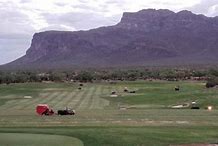Even before the hot weather dissipates…most golf courses in the west and southeast have to plan when they undertake a major transformation. In Tucson and other warmer climes, the cooler winter weather causes the Bermuda grass to go dormant. It’s loses all of it’s color, looking more like cut straw, than luxurious turf. Hence, the need to overseed.
It’s a laborious, tedious and expensive proposition. Most of your favorite courses will be closed from one to two weeks from early September to the end of October, while they choke off the water to dry everything out, then cut the bermuda down to the nub, spread the rye seed and the fertilizer and then drench the course with water…a lot of it. Then they have to wait a week for it to grow in. It’s all done to pass the eye test for the recreational golfer. Most golf course managers believe they need to do it to get golfers during the winter months…the time when they can charge the most and get the most golfers.
Here in Tucson, every course overseeds…some more than others. Some will just do fairways and tees. Some will just do tees and around greens. Others will do it all. Ventana Canyon has 36 holes…they overseed everywhere. According to a U of A News story, the general cost for them is in the neighborhood of $250,000…not including the lost revenue while they’re closed. Most courses expect to shell out about $30-40,000 per 18 holes.
 That doesn’t include the increased cost of water after the seed gets thrown down. It needs to get soaked. And if the courses don’t get the play expected from the greening of the course…they might get soaked in a different way.
That doesn’t include the increased cost of water after the seed gets thrown down. It needs to get soaked. And if the courses don’t get the play expected from the greening of the course…they might get soaked in a different way.
Since the recession, golf course managers have been rethinking the whole overseeding thing. At the hallowed grounds of Pinehurst in North Carolina, it was determined that overseeding may not be the best way to go, but instead (heaven forbid) they decided to paint the dormant bermuda, green. Old time Tucsonans’ may remember that the Tucson Open painted the fairways at Tucson National during the 70’s…to look better for TV. However, during those days, the paint was a little suspect. The product has seen some upgrades since then. Pinehurst found a certain paint that did not turn colors after a while like similar products used to (think of the football field at Boise State). And much to the delight of course management…the golfers still came. A lot of players like the extra ball roll and the firmer conditions, the way the ball sits up on the dormant Bermuda…instead of the feel they get swinging through the sticky rye. For Pinehurst it works. They save $15,000 a year for each of their 9 courses by not overseeding….not including the savings on water. Dormant Bermuda requires very little, if any water.
Painting dormant Bermuda is better for a course that gets less play, let’s say 30,000 rounds a year. Since it’s not growing, the grass won’t come back after a divot is made. So, the course will start looking bad if it gets too much play, even with the paint.

So, while painting fairways has not caught on yet in Arizona…the improved quality of the paint and economics of it may increase the probability in the future. Don’t be surprised if one day you hit your shot and clean the green off your clubface and realize it’s from the paint instead of the grass.
By Mike Boyd


